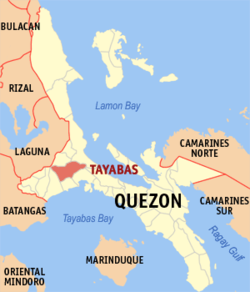Tayabas
| Tayabas | |||||||
|---|---|---|---|---|---|---|---|
| Component City | |||||||
| City of Tayabas Lungsod ng Tayabas |
|||||||
Malagonlong Bridge, Minor Basilica of Saint Michael Archangel, Casa Comunidad de Tayabas, City Hall of Tayabas, Tayabas Rice Terraces
|
|||||||
|
|||||||
| Nickname(s): City of Festivals Home of The Finest Lambanog Rest and Recreation Destination of Quezon City of 11 Spanish Bridges |
|||||||
 Map of Quezon showing the location of Tayabas |
|||||||
| Location within the Philippines | |||||||
| Coordinates: 14°01′N 121°35′E / 14.017°N 121.583°ECoordinates: 14°01′N 121°35′E / 14.017°N 121.583°E | |||||||
| Country | Philippines | ||||||
| Region | CALABARZON (Region IV-A) | ||||||
| Province | Quezon | ||||||
| District | 1st district of Quezon | ||||||
| Founded | 1578 | ||||||
| Cityhood | 1703 | ||||||
| Reestablished | July 14, 2007 | ||||||
| Reaffirmed | February 15, 2011 | ||||||
| Barangays | 66 | ||||||
| Government | |||||||
| • Mayor | Ernida Reynoso | ||||||
| Area | |||||||
| • Total | 230.95 km2 (89.17 sq mi) | ||||||
| Population (2015) | |||||||
| • Total | 99,779 | ||||||
| • Density | 430/km2 (1,100/sq mi) | ||||||
| Demonym(s) | Tayabasin, Tayabense | ||||||
| Time zone | PST (UTC+8) | ||||||
| ZIP code | 4327 | ||||||
| Dialing code | 42 | ||||||
| Income class | 6th class, partially urban | ||||||
| Website | tayabas |
||||||
Tayabas, officially the City of Tayabas (Filipino: Lungsod ng Tayabas), is a city located in Quezon Province, the Philippines. According to the 2015 census, it has a population of 99,779 people. Tayabas is known for lambanog (coconut arrack) and sweet food/delicacies, as well as tourism resorts. Tayabas is also known as the City of Festivals because of its colorful festivals. The city is famous for resorts, heritage houses, historical landmarks, rest and recreation destination and festivities. It is the former capital of the Province of Tayabas, now Aurora and Quezon.
Tayabas is politically subdivided into 66 barangays.
In 1578, Fray Juan de Plasencia and Fray Diego de Oropesa, two Franciscan missionaries from Spain founded the town of Tayabas in order to spread Christianity to its natives. Prior to the occupation, however, the native Tayabenses lived in rural settings typical to those times, with barangays headed by village chiefs and councils of elders.
From 1749 to 1901, Tayabas was the capital of the Province of Tayabas, now known as Quezon. In the 19th century, Tayabas was among the biggest towns in the country. Its Minor Basilica of St. Michael the Archangel, which was enlarged in the mid-1850s, is the longest church in the country and is a lasting testament to its glorious and historic past.
In more than three centuries of Spanish occupation, only eight cities and towns were given the title of Villa, and Tayabas was one of them. These are La Villa del Santisimo Nombre de Jesus de Cebu in 1565, La Villa de Santiago de Libon (Albay, 1573), La Villa Fernandina de Vigan (Ilocos, 1574), La Villa Rica de Arevalo (Iloilo, 1581), La Noble Villa de Pila (Laguna, 1610), La Muy Noble Villa de Tayabas, (Tayabas, 1703), La Villa de Bacolor (Pampanga, 1765), La Villa de Lipa (Batangas, 1887). Interestingly, that Tayabas was given the title of 'most noble' villa even before it became the provincial capital shows its importance even before 1749.
In the book "The Philippines," written by French traveler Jean Baptiste Mallat, and published in 1846, it appears that Tayabas had more than 21,000 people at that time. This was reduced to 16,000 when Lucena became an independent town in 1879. Due to low population growth during the Spanish period, this number remained unchanged until the coming of the Americans.
...
Wikipedia







